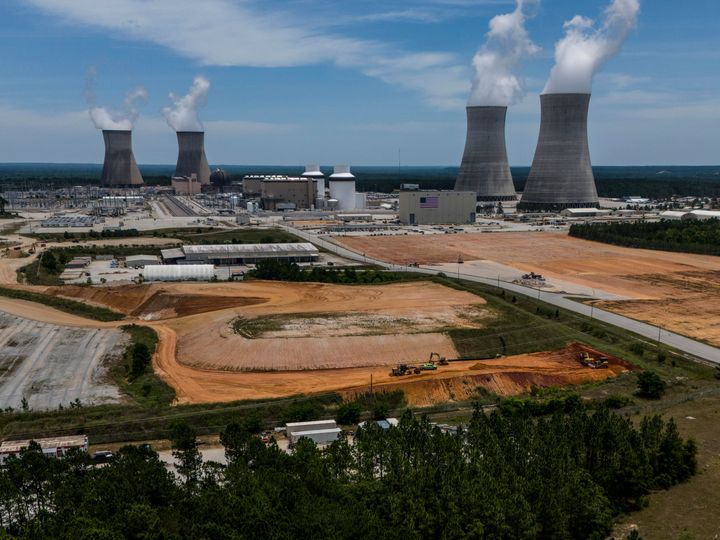JD Vance touted the benefits of nuclear power on Joe Rogan’s podcast and proposed spending as much as it costs to build an aircraft carrier to provide the United States’ electrical grid with enough equipment to quickly restore service after a major blackout.
During a three-hour interview published Thursday morning, the Republican vice presidential nominee repeatedly criticized environmental groups for what he saw as the hypocrisy of opposing the most efficient and abundant form of carbon-free electricity while also describing planet-heating emissions as an existential threat.
“If you think that carbon is the most significant thing — [that] the sole focus of American civilization should be to reduce the carbon footprint of the world — then you would be investing in nuclear in a big way,” Vance said.
“When you say that, the environmentalists say, ‘Well, you’ve got all these poison rocks to deal with afterwards,’” he added, referring to radioactive waste left behind when a reactor refuels with freshly enriched uranium. “Well, the poison rocks problem is a less significant problem than the carbon problem, if you think we’re all going to go extinct in 100 years. So let’s deal with the most pressing problem.”
Nuclear power stations produce relatively miniscule amounts of physical waste per unit of electricity generated, compared to the mountains of toxic ash spewed by coal plants or the unrecyclable wind turbine blades and solar panels now piling up in landfills.
Unlike other forms of waste, every bit of spent nuclear fuel is highly regulated and monitored by national and international authorities. The vast majority of spent nuclear fuel remains on-site at power plants, waiting for the federal government to establish a plan for what to do with it in the long term. It will take millennia to decompose.

The U.S. built, then abandoned, a facility in Nevada’s Yucca Mountain to store nuclear waste indefinitely. Finland just opened the world’s first permanent waste repository, where sealed containers of spent fuel rods can be buried deep underground. But France, Russia and the United Kingdom recycle their spent nuclear fuel, which still contains roughly 95% of its energy after coming out of a reactor, turning it into fresh fuel or extracting valuable radioactive isotopes for medical treatments.
The U.S. canceled its first nuclear waste recycling facility in the 1970s, but several new companies are working on commercializing technologies to reprocess spent fuel with funding from the federal government.
Vance’s comments sharply contrast with those of his running mate, former President Donald Trump, who in an appearance on Rogan’s show last week warned that nuclear reactors cost too much and carry “dangers.” (That’s a flip from as recently as August, when Trump told conservative podcaster Shawn Ryan that “nuclear now has become very good, very safe.”)
During his term in the White House, Trump signed two major laws supporting nuclear power and took some executive actions to support the sector. But momentum for an industry revival hit critical mass under President Joe Biden, whose landmark infrastructure law pumped billions into preserving existing reactors and testing and building new reactors. The law also offered long-term tax credits for any kind of carbon-free electricity, including nuclear power.
If elected, Trump and Vance have vowed to rescind many of those subsidies.
Vance also called Russia the “biggest funder of the green energy movement in Europe.” While that claim is almost certainly exaggerated, a 2022 report by the Foundation for Political Innovation, a liberal think tank headquartered in Paris, found Russia’s state-owned Gazprom gas company funded particular environmental nonprofits that promoted the permanent phase-out of nuclear power in countries such as Belgium. Before taking office as the Belgian energy minister in 2020 and setting in motion plans to shut down the country’s nuclear plants, Tinne Van der Straeten, a member of the Green Party, owned 50% of a law firm where Gazprom was a top client.

“Why are the Russians funding? It’s not because they care about climate change. It’s because they want the Germans and everybody else to buy Russian natural gas,” Vance said. “They realize that if the Germans and French close down all their coal and nuclear factories, Russia is going to have them by the balls.”
Still, Vance — whose campaign has vowed to ratchet up already-historically-high levels of oil and gas production in the U.S. — cast doubt over the urgency of slashing output of greenhouse gas emissions.
Deriding climate advocates as “carbon obsessives,” he said the lingering hesitance among some activists to support nuclear power showed “they obviously don’t believe their own bullshit, which is why I’m skeptical of what they say.”
Then the GOP vice presidential nominee pivoted to another wonky energy policy issue: the nation’s supply of electrical transformers.
As extreme weather events become more common ― something scientists say has been spurred rising temperatures ― massive storms have been destroying electrical transformers at a growing clip. Transformers are the backbone of the power grid, acting like lock systems in a canal to raise and lower electricity levels as electrons move from generators through wires and into wall outlets.
As intense storms and heat waves take a toll on existing transformers, overdue upgrades to the aging power grid are driving up demand for replacements.
Your Support Has Never Been More Critical
Already contributed? Log in to hide these messages.
Yet manufacturers are struggling to keep up. In the face of a nationwide shortage, the Biden administration in April dialed back a regulatory reform that factory owners complained was keeping them from ramping up production of the transformers in demand today.
Vance made no mention of the effects climate change has had on the nation’s supply of transformers. Instead, he described a so-far fictional scenario in which the U.S. could be hit with an electromagnetic pulse that would fry the electrical grid — something federal experts say would be possible if an adversary detonated an atomic bomb at a high altitude above the U.S. Americans have only ever experienced one such event, when a pulse from a nuclear bomb test in the Pacific traveled 800 miles east, briefly disrupting street lights and telephone service in parts of Hawaii.
To guarantee a fast recovery from such an attack, Vance said, the federal government should stockpile enough spare transformers to swap out with busted ones.
“It’s actually a scandal, I think, that the federal government has not — at one point, with all the money that we spend on defense and everything else — just said, we’re going to spend $15 billion to buy enough power transformers to have a backup for every transformer in the country,” he said.

